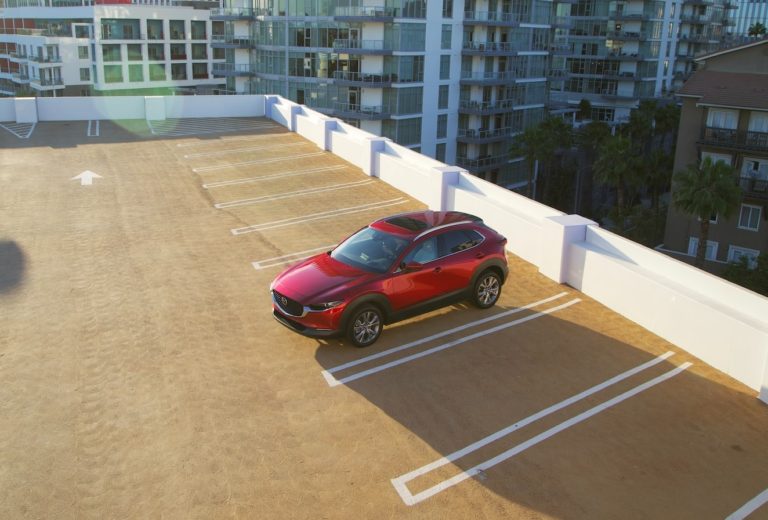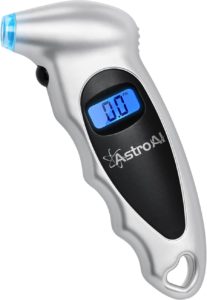Steps to Reset Mazda CX-30 TPMS
Step 1: Check and Adjust the Tire Pressure
Since the newest Mazda models including the CX-30 no longer have tire pressure reset buttons, this is clearly the most important step to turn off your tire pressure light. Open your driver side door and find the yellow sticker. The front tires should be set to 36 PSI and the rears should also be set to 36 PSI. Always adjust your tire pressures when your tires are cold. Adjust your tires accordingly so they are now 36 Psi.
Step 2: Drive the Car
After adjusting your tire pressures to the cold recommended pressure, drive the car. Mazda says you need to drive the car for at least 3 minutes at speeds of at least 16 Mph. After driving the vehicle, the tire pressure light will go off.
Step 3: Re-Check Your Tire Pressure
If the tire pressure light doesn’t go off after step 1 and step 2, recheck your tire pressure. Confirm that the pressure is still at exactly 36 Psi. If it’s not, you likely have a tire leak or some sort of puncture.
Mazda CX-30 TPMS Malfunction Indicator
Your Mazda CX-30 features a clever TPMS malfunction indicator designed to inform you when the system isn’t functioning as intended. This indicator shares the same dashboard light as the low tire pressure warning but serves a distinct purpose. Should the TPMS encounter a problem, the warning light will blink for approximately one minute before remaining illuminated consistently. This sequence will recur each time the car is started until the issue is resolved. Be aware that while the indicator is active, the system may not effectively notify you of low tire pressure. (Basically, your tire pressure monitoring system won’t work correctly until the problem with the system is resolved) Various factors, such as incompatible tires or wheels or a faulty tire pressure sensor will trigger TPMS issues. Always inspect the TPMS malfunction indicator after altering tires or wheels on your vehicle to guarantee seamless operation. In other words, if you have a blinking tire pressure light, you have a problem with the TPMS system itself, not an air pressure problem. To determine the problem sensor you will need a TPMS diagnostic tool like this Autel TPMS tool.
Always Reset TPMS in These Cases:
After tire pressure has been adjusted
After tire rotation has been performed
After any tire or wheel has been replaced.
After when the vehicle battery dies, been drained, or jumped.
After the TPMS light turns on.
How Mazda Cx-30 Tire Pressure Monitoring System Works
Pressure sensors: Each tire is equipped with individual pressure sensors that constantly monitor the air pressure within the tire.
Data transmission: These sensors wirelessly transmit real-time tire pressure data to the vehicle’s onboard computer system.
Sensor batteries: The pressure sensors are powered by long-lasting batteries, typically lasting for several years. (Usually around 5 to 7 years)
Vehicle start-up: Upon starting the vehicle, the TPMS automatically initializes and begins receiving data from the tire pressure sensors.
Continuous monitoring: The system continuously monitors tire pressure while the vehicle is in motion, ensuring that the pressure remains within the recommended range.
Warning thresholds: The TPMS is pre-programmed with specific pressure thresholds for each tire, based on Mazda’s recommendations.
Pressure variations: If the tire pressure fluctuates beyond the set thresholds (either too high or too low), the TPMS will trigger a warning.
Warning light activation: When a tire pressure issue is detected, the TPMS illuminates a warning light on the vehicle’s dashboard to alert the driver.
Error codes: In addition to the warning light, the TPMS may also provide error codes or specific information regarding which tire is experiencing pressure issues.
Benefits of TPMS in Mazda CX-30
Improved safety: By constantly monitoring tire pressure, the TPMS helps maintain optimal vehicle handling and stability, reducing the risk of accidents caused by underinflated or overinflated tires.
Prolonged tire life: Maintaining proper tire pressure helps prevent uneven wear and tear, extending the lifespan of your tires.
Enhanced fuel efficiency: Properly inflated tires improve fuel economy by reducing rolling resistance, allowing your Mazda’s engine to work efficiently.
Reduced environmental impact: Improved fuel efficiency leads to lower greenhouse gas emissions, contributing to a cleaner environment.
Real-time alerts: The TPMS provides instant notifications on the dashboard when tire pressure falls outside the recommended range, allowing drivers to address the issue promptly.
Increased convenience: The system eliminates the need for frequent manual tire pressure checks, saving time and effort for drivers.
Cost savings: By helping to optimize tire life and fuel efficiency, the TPMS ultimately saves drivers money on tire replacements , fuel expenses, and potentially suspension issues.
Maintenance reminders: The system may also notify drivers when it’s time for routine maintenance, such as sensor battery replacements or system recalibration. (this is what the TPMS malfunction indicator is for)
Comprehensive information: In addition to warning lights, the TPMS can provide detailed information on tire pressure levels and which specific tire is experiencing an issue, enabling drivers to take appropriate action.
Conclusion
Resetting the tire pressure warning light on a 2022 Mazda CX-30 is an uncomplicated and direct procedure that can be achieved with just a few actions. By adhering to the steps detailed in this article, you can guarantee that your tire pressure monitoring system operates precisely, and your Mazda CX-30 maintains optimal performance.



